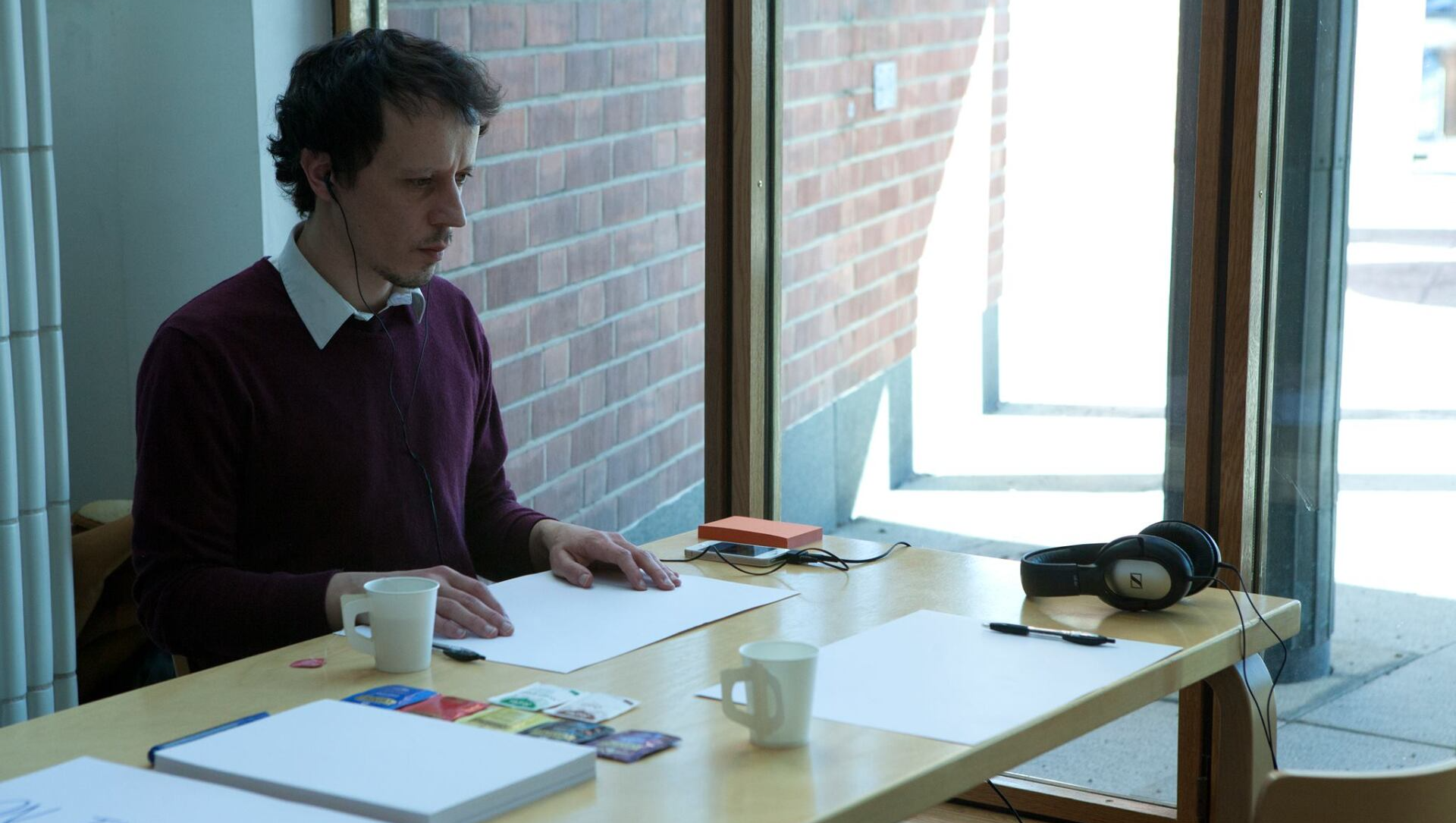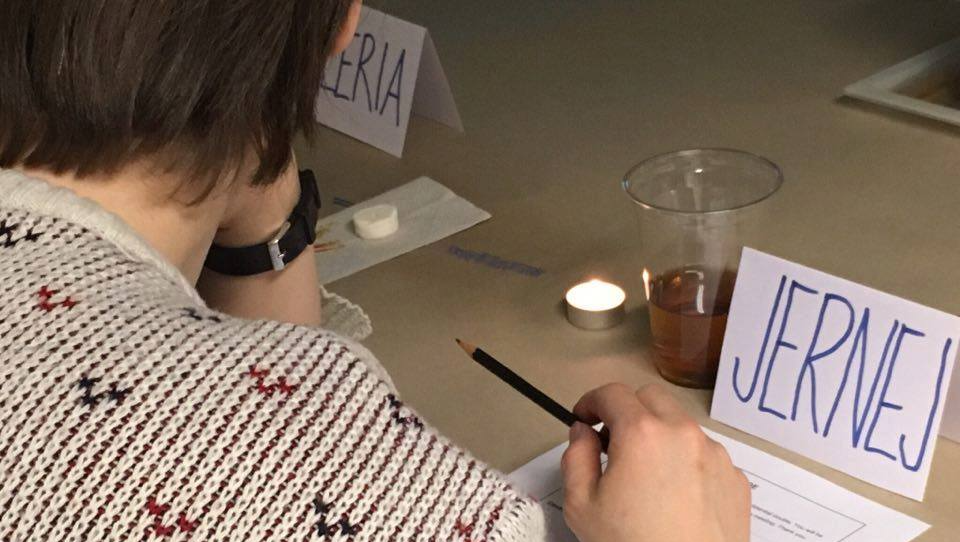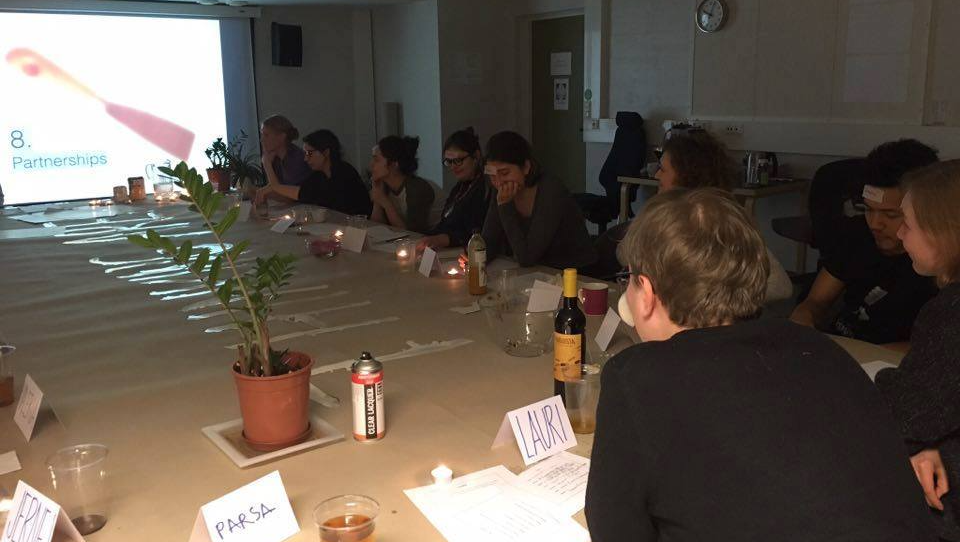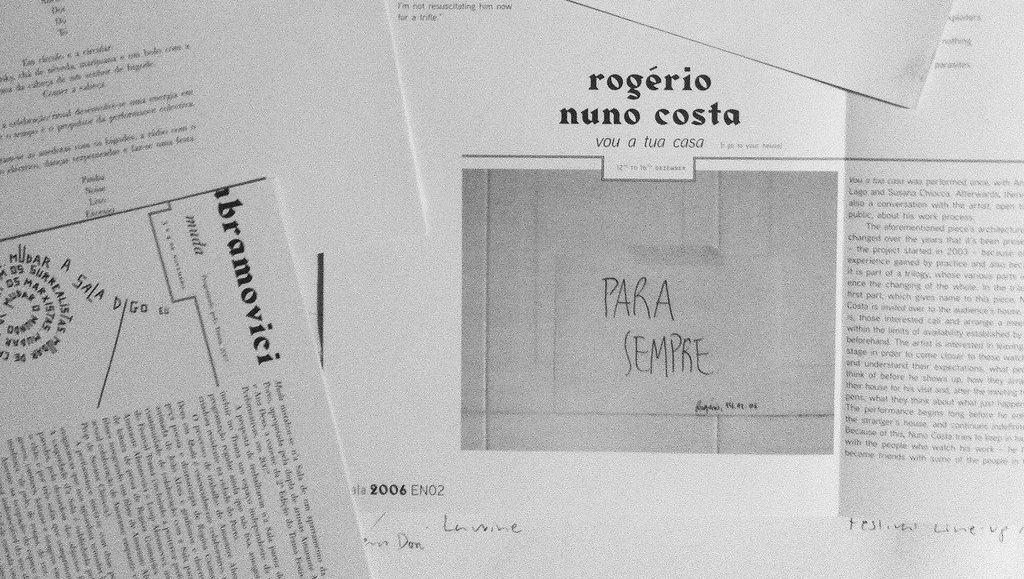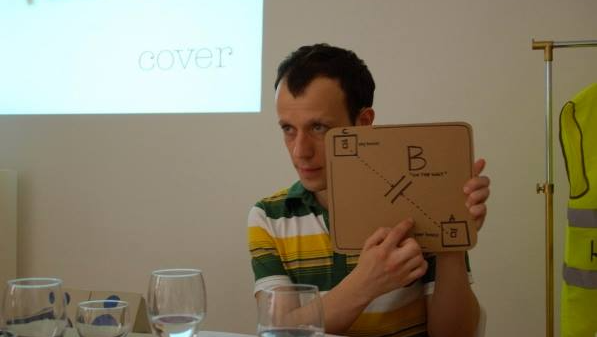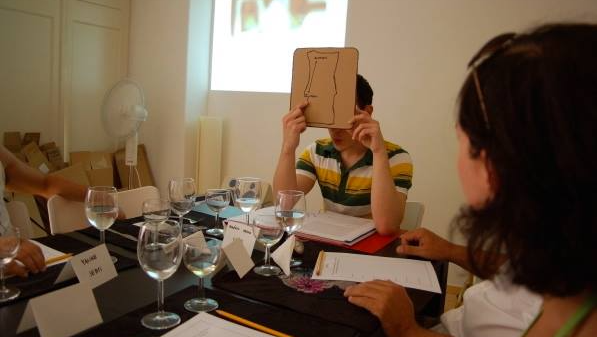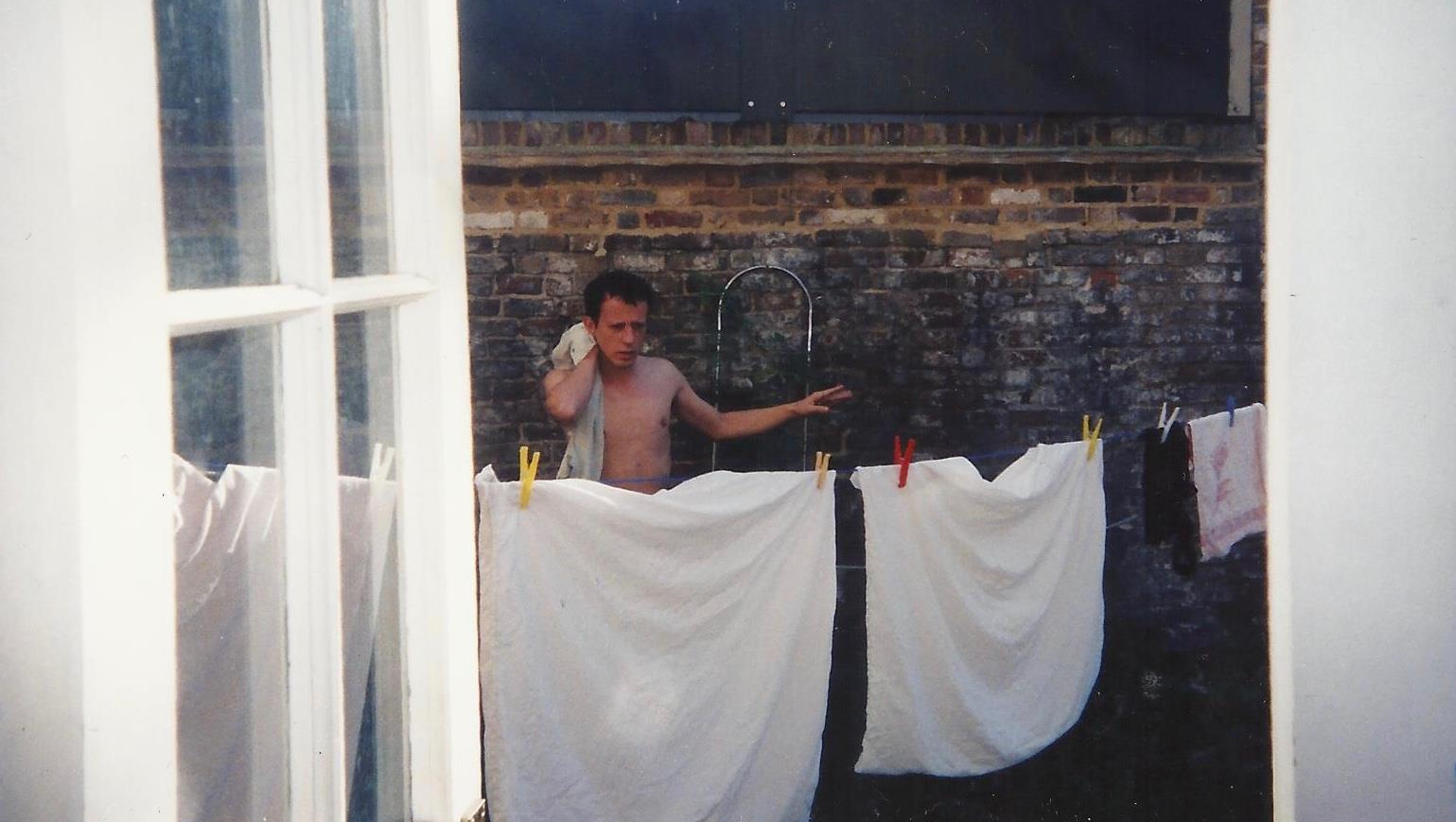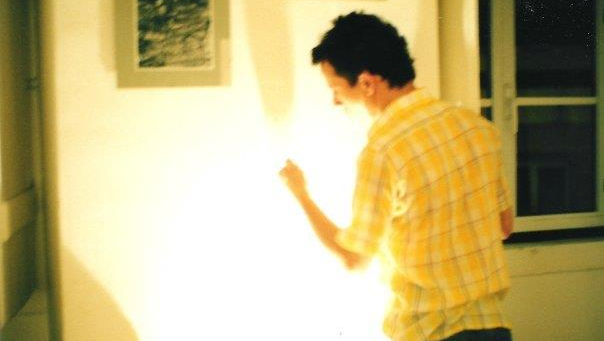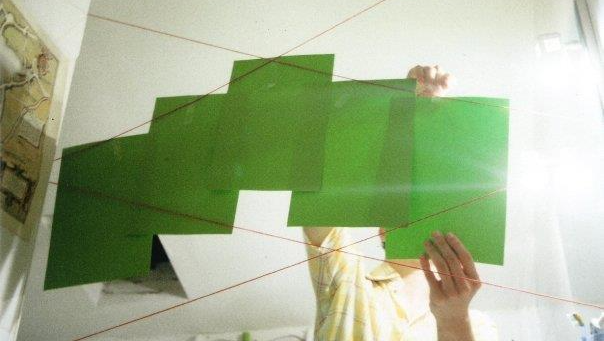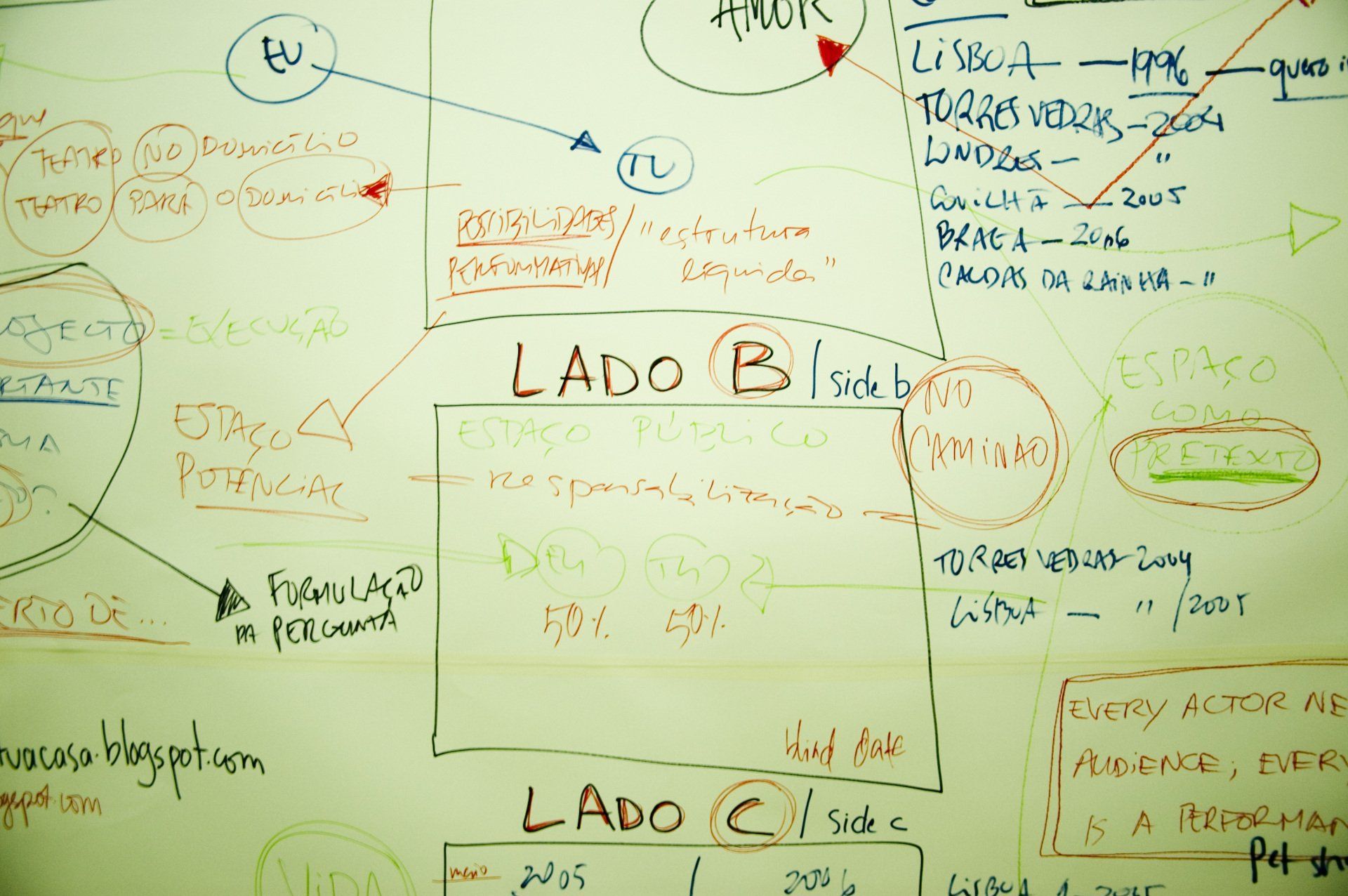Vou A Tua Casa
TRILOGY
Vou A Tua Casa [literal translation:
I Go To Your House; official English title: Going To Your Place] is a performance trilogy written and performed by Rogério Nuno Costa, that ran from 2003 to 2006 in many Portuguese cities and towns (Lisbon, Porto, Évora, Covilhã, Braga, Amares, Caldas da Rainha, Torres Vedras, Guimarães), and also in London (UK), Hamburg (Germany), Kortrijk (Belgium), Arnhem (The Netherlands), Berlin (Germany), Espoo and Helsinki (Finland). The first part of the trilogy [also known as
Lado A / A-Side], happened in the spectators’ homes (up to 5 spectators per house). The second part, sub-titled “No Caminho” [On The Way, or B-Side] was a one-to-one encounter between Rogério Nuno Costa and a spectator, who had to choose the public place for the performance to happen beforehand. The third and last performance, sub-titled “Lado C” [C Side], happened in Rogério Nuno Costa’s own apartment for a group of 6 spectators, 1 specialised observer, 1 invited artist and 1 kitchen assistant;
C Side consisted in a hybrid event, offering an immersive theatrical experience, a dinner and a lecture-performance, where the audience was invited to join an ephemeral gastro-club founded to help the artist solve his personal/professional struggles. A subtle storyline links the three performative moments within an urban itinerary, stated in the trilogy’s poetic description: “Vou A Tua Casa is a three-part geo-emotional path in the city; the first part is your house, the last part is mine, the part in-between resides in that impossible ‘on-the-way’ space in between, where we both might finally touch each other.”
Following the end of the performance-based pieces, the project “Vou A Tua Casa” proceeded to its documental phase. DOCUMENTATION PROJECT [2006/07; online publishing date: 2011] is a cross-disciplinary editorial platform, compiling a set of documental materials produced and collected during the public presentations of the trilogy in a book and a video documentary. More than a speculation around the residues left by a particularly fragile group of performances, the project was built upon the
documental
practice itself, hence operating critically in such concepts as
ephemerality, memory, intimacy, public/private spaces, site-specificity and autobiography. In 2023, the 20th anniversary of "Vou A Tua Casa" will be celebrated with the publishing of a bilingual book/catalogue titled “Going To Your Place - Documentation Project” by Lisbon’s publisher
Sistema Solar, along with reenactments and adaptations of the 3 performances by Rogério Nuno Costa and guest artists.
VOU A TUA CASA [LADO A]
GOING TO YOUR PLACE [A-SIDE]
The title is literal. I like them that way. I don’t believe in poetic, symbolic, philosophically enigmatic, sophisticated, occult, encrypted titles. VOU A TUA CASA does not cheat; but it could potentially scare, even though its main purpose is as simple as this: an (urgent) performer going to someone’s home. Nothing more than an artistic, theatrical adventure constantly escaping space and time. Questioning the limits of theatricality and performativity always comes along, but that doesn’t interest me. My attention is caught by people, their houses, and the fact that I go and visit them; this being more or less ‘theatre’, more or less ‘performance/live art’, more or less ‘spectacular’, matters too little. The things that drive the urgency of me going, doing, seeing, touching, loving, and then leaving, are filled with mischievous tricks and hooded lies. I do like to fake… pretend that I am thrilled, for instance. I do not believe in “truth”. It’s false that there are people, houses, and me visiting them. The city lies, it is “unvisitable”. I trespass it fleetingly and get comfort and shelter inside. Exactly there. Where you are.
Presentations: Lisbon (2003/04), Torres Vedras (A8 Festival, 2004), London (Postscript Festival, 2004), Covilhã (Quarta Parede, 2006), Kortrijk (Fresh Festival, 2006/seminar), Braga (Censura Prévia, 2006), Caldas da Rainha (Sonda Festival, 2006), Porto (A Sala, 2007), Hamburg (Dance Kiosk Festival, 2007), Helsinki (feat. Stop Deportations, Rautatientori, 2017).
NO CAMINHO [LADO B]
ON THE WAY [B-SIDE]
Between your house — where I have been —, and mine — where I wish you could be —, there is a point in the middle. A point underway. On the way. If you might catch me there, I would be able to tell you the secret, unmask everything, unmask myself. In that impossible underway place where it is possible for us to breathe at the same time, I want to be part of your world. Permanently and helplessly. Nothing else matters but what I have to tell you, in that precise moment, and also all the things you want me to cut out. I will throw away as much of my real life as your will to SEE a performance might eventually dictate. And then it’s gonna be forever. Until I have enough. Until you have enough. And our “special moment” may therefore succumb to the natural laws of universe.
Presentations: Torres Vedras (A8 Festival, 2004), Lisbon (2005), Bucharest (E-motional | Re-thinking Dance, ODD Gallery & Modulab/seminar, 2015), Espoo [Aalto University Learning Centre's lobby, "Hi-stories" exhibition curated by Ksenia Kaverina, 2017).
LADO C
C-SIDE
At the dinner table: 15 spectators [pretending to be students or members of some sort of anonymous corporation], an artist [pretending to be a cooking teacher or the guru of a brand new conceptual-nominalist sect], a mysterious observer [pretending not to know anything about the event, but having rehearsed his role very well…], and another artist, invited by the first to boycott 5 minutes of the show. Rhetorically speaking, C-SIDE is an “under construction” event; the performance itself is discussed, and the roles the participants have to perform are indefinable, interchangeable and constantly put into question. The goal is to reflect upon the reasons behind the fact that we are “there”, not in some other place. That is: domestic marketing, office appliances buy&sell, Portuguese nouvelle cuisine, the cure for migraines, Google searches, ultra-secret conspiracies, art funding applications, 90s fashion tutorials, emo-teen sleepovers, post-truth or post-dare, second hand embarrassments and cheer-leader routines, all mixed up in a nutritional, ergonomic, esoteric, medicinal and hipsta-cool-tural event. C-SIDE is an unusual performance, at the same time welcoming and ambiguous, effortlessly agreeing with “reality” first, in order to change it afterwards. Thomas Hirschhorn, who does a cameo appearance in the performance, would say: this is not “political”, but it is “politically” performed. An extraordinary rendezvous of people who meet to solve one artist’s problems, in exchange of gourmet food and curriculum vitae credits.
C-SIDE was funded by Direcção-Geral das Artes/Ministry of Culture (Portugal), with the support of Transforma AC, DIF/Publicards, Festival Alkantara, Companhia de Dança Contemporânea de Évora, EIRA, Cão Solteiro, Escola Superior de Comunicação Social, LUPA Festival, Encontrarte Festival and Ballet Contemporâneo do Norte [Associated Artist].
Presentations: Lisbon (Alkantara Festival, 2006), Évora (Festival Internacional de Dança Contemporânea "Habitar A Cidade", 2006), Porto (LUPA Festival, 2009), Amares (Encontrarte Festival, 2009), Lisbon (Geraldine, 2011), Espoo (ArtHouse, 2017), Guimarães (Casa da Memória, “Intimacy & Performance International Colloquium”, 2018).
Compilation
The dramaturgy of the being in everyday life
Mónica Guerreiro
“What would happen if a stranger suddenly got into your house, presenting himself as an actor and proposing a different formula of dramatic experience? An experience that has for first aim the will to take further the spectators’s perception towards the everyday life objects and facts. To invade that intimacy, to seize part of the privacy of someone watching (and allowing to be watched) are Rogério Nuno Costa’s foundations for the Going To Your Place project. Going to the spectators’ houses was not exactly the most important thing: the sum of possibilities opened by the thousands of different props, as well as the various chances of dramaturgical deflection in each corner or room, offered the spectator a brand new challenge and a very different theatrical adventure. This is absolutely not about taking theatre to one’s home, but to give a sort of “home-like face” to the theatrical game, by playing with a group of circumstances for the performer to study and to integrate in real time. The simple presence of another person – the spectator –, transfigures this simple action of discovering one’s place into something else: while exploring the space in which he enters for the first time, Rogério/performer gives us, minute after minute, various signals that help us following him across the path of the performance we’re in. This is obviously a theatrical exercise, but also a sociological experience that puts in question the way we build up our private life configurations. This character of ephemeral transformation functions as an action primordial principle for Going To Your Place: the leaving of the performer coincides with the erasure fo every particle of his presence, as well as with that feeling of abandonment one feels in every performance’s end. Nonetheless, the reciprocity of the experience assumes here unusual outlines: the unpredictableness exists in distinguished doses for both spectator and performer; the space/time logic, even when it’s appropriated creatively by the author/performer, is a spectator’s decision in the first place; the relative fragility of the performer’s role, away from the security of the set and put in a potential position of guest (with all the usual discomfort brought by that position), rather than in the position of the action leader. How does Rogério Nuno Costa achieves, with this performance, a strategy of subversion upon the conventional patterns of representation? Just to get into the triviality of definitions (there’s no need to relate to details of the performance content), I would say that this sense of theatre as an “act of will” (Peter Brook would say…) is taken to its limits by Rogério Nuno Costa as a pretext for the consecration of this minimum common denominator: a constructed artificiality and a spectator. In other words, a common space, a will to see and a will to be seen.”
[in Sinais de Cena, performing arts magazine, nr. 1, Lisbon 2004]
FURTHER READING/VIEWING
Online Catalogue [PT/ENG]
Blog [PT]
Youtube [PT/ENG]
Facebook [ENG]
Photo Gallery [ENG]
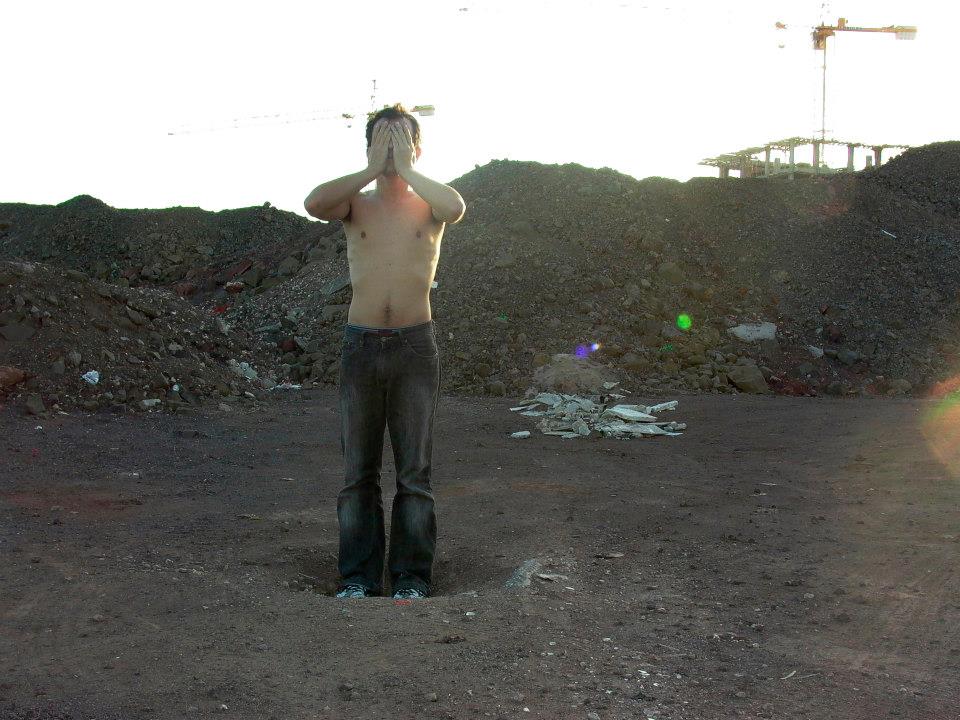
No Caminho / On The Way © Luísa Casella
Lisbon 2005





